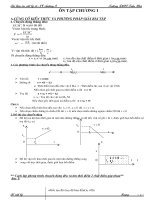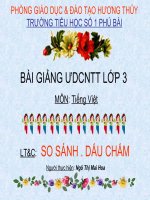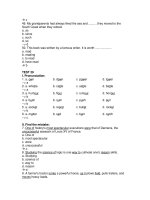Astm c 285 10 (2015)e1
Bạn đang xem bản rút gọn của tài liệu. Xem và tải ngay bản đầy đủ của tài liệu tại đây (76.08 KB, 3 trang )
Designation: C285 − 10 (Reapproved 2015)´1
Standard Test Methods for
Sieve Analysis of Wet-Milled and Dry-Milled Porcelain
Enamel1
This standard is issued under the fixed designation C285; the number immediately following the designation indicates the year of
original adoption or, in the case of revision, the year of last revision. A number in parentheses indicates the year of last reapproval. A
superscript epsilon (´) indicates an editorial change since the last revision or reapproval.
ε1 NOTE—Sections 4 and 10 corrected editorially in May 2015.
INTRODUCTION
These test methods provide a rapid means of determining the fineness of glass frit in wet- or
dry-milled porcelain enamel coating materials by sieve analysis. Fineness is a key predicator of
fusibility, tearing, gloss, opacity, suspension in the slip, and ease of spraying because of the direct
relationship to surface area.
2. Referenced Documents
1. Scope
2.1 ASTM Standards:2
E11 Specification for Woven Wire Test Sieve Cloth and Test
Sieves
1.1 These test methods cover the determination of the
fineness of frit in wet- or dry-milled porcelain enamels and
other ceramic coatings for metals by means of the No. 200
(75-µm) or No. 325 (45-µm) sieve.
3. Significance and Use
1.2 The two methods appear as follows:
3.1 The fineness of the frit has a direct bearing on many of
its properties, such as fusibility, tearing, gloss, opacity, suspension in the slip, and ease of spraying.
Sections
Method A—Referee Method
Method B—Routine Method
4 to 9
10 to 14
METHOD A—REFEREE METHOD
1.3 Method A is intended for use where a referee method of
higher accuracy is required, while Method B is intended to
meet the needs of normal enamel plant production control
operations where a rapid, simplified method of sieve testing is
required. The accuracy of the simplified method has proved to
be entirely adequate for this use. The simplified test, however,
is not recommended where high accuracy is required.
1.4 This standard does not purport to address all of the
safety concerns, if any, associated with its use. It is the
responsibility of the user of this standard to establish appropriate safety and health practices and determine the applicability of regulatory limitations prior to use.
4. Apparatus
4.1 Balance—The balance or scale shall be of at least 500-g
capacity, and accurate to 0.1 g.
4.2 Sieves—The sieves shall conform to Specification E11.
They shall include the No. 40 (425-µm) sieve and also the No.
200 (75-µm) or the No. 325 (45-µm) sieve, or both. A No. 325
sieve shall be used when the fineness is such that, from a
sample containing 100 g of dry solids, less than 2 g is retained
on a No. 200 sieve. An 8-in. (203-mm) full-height sieve is
recommended. This height is preferred because there is less
tendency to flood or splash, and also because it fits commercial
automatic tapping and shaking machines. All sieves used for
1
These test methods are under the jurisdiction of ASTM Committee B08 on
Metallic and Inorganic Coatings and are the direct responsibility of Subcommittee
B08.12 on Materials for Porcelain Enamel and Ceramic-Metal Systems.
Current edition approved May 1, 2015. Published May 2015. Originally
approved in 1951. Last previous edition approved in 2010 as C285 – 10. DOI:
10.1520/C0285-10R15.
2
For referenced ASTM standards, visit the ASTM website, www.astm.org, or
contact ASTM Customer Service at For Annual Book of ASTM
Standards volume information, refer to the standard’s Document Summary page on
the ASTM website.
Copyright © ASTM International, 100 Barr Harbor Drive, PO Box C700, West Conshohocken, PA 19428-2959. United States
1
C285 − 10 (2015)´1
inclination at a rate of about 150 times per minute, and strike
against the palm of the other hand at the top of each stroke.
After every 25 strokes, turn the sieve about one sixth of a
revolution in the same direction. Continue the operation until
not more than 0.05 g passes through the sieve in 1 min of
continuous sieving. Weigh the portion of the sample retained
on the sieve to the nearest 0.1 g.
testing shall be standardized initially and after every 50 tests
against a reference sieve tested by the National Bureau of
Standards and bearing its precision seal. The correction for the
sieve used in this test shall be determined by sieving tests made
in conformity with the procedure of this test method. Identical
samples shall be sieved through the reference sieve and the test
sieve. Test materials shall be chosen so that 5 to 10 % of the
material will be retained on the reference sieve. The difference
between the percentage residue on the reference sieve and that
on the test sieve is the amount of correction which shall be
algebraically added to, or subtracted from, the correction for
the reference sieve to obtain the final correction (Note 1). The
No. 40 sieve need not be calibrated.
6.3 Machine Sieving—If a mechanically operated sieve
shaker is used, vary the time during which the sieve (with pan
and cover attached) and the sample are shaken, and note the
length of time necessary to operate the sieve shaker in order to
get the same result as that obtained with hand sieving.
Calibrate the machine-sieving operation in terms of hand
sieving.
NOTE 1—For example, when comparing the reference sieve with a test
sieve, should 8.5 g be retained on the reference sieve and 7.5 g on the test
sieve, the total correction for the test sieve would then be 8.5 − 7.5,
or + 1.0.
7. Procedure for Dry-Milled Enamel
7.1 Transfer the sample quantitatively to the No. 200 or 325
sieve. Complete the sieving and weighing operation in accordance with 5.2 or 5.3. Make tests in duplicate.
4.3 Dryer—A suitable means for drying the sieves and slip
sample, without exceeding a temperature of 250°F (122°C),
shall be provided. No dryer is needed for sieve tests of
dry-milled enamel.
8. Calculation and Report
8.1 Using the average of duplicate runs, report the fineness
of the frit in percentage by mass (to the nearest 0.1 %) of the
dry solids content of the sample retained on the No. 200 or 325
sieve. The weight in grams is equivalent to weight percentage.
4.4 Mechanically Operated Sieve Shaker— The mechanical
shaking device shall be such as to produce a lateral and vertical
motion of the sieve, accompanied by a jarring action so as to
keep the sample moving continuously over the surface of the
sieve. If a machine shaker is to be used, the thoroughness of
sieving shall be tested by comparing and calibrating with the
hand method of sieving, as described in Section 6.
9. Precision and Bias
9.1 Precision—It is generally accepted within the porcelain
enamel industry that duplicate tests run by the same operator in
the same laboratory should show a precision of 60.5 or less.
Failure to duplicate determinations within this limit indicates
the necessity for repetition of the test. The precision of
duplicate tests is negatively influenced by variations in operator technique, sieve binding and wear, and, when it is used, the
condition of mechanical sieving equipment. It is also influenced by changing conditions in the test sample which occur
over time and which result in particle agglomeration due to
chemical reactions.
5. Sample
5.1 Wet-Milled Enamel—Select a sample of slip representative of the material to be tested. Protect samples from evaporation. Determine the water content of the slip by drying a
representative 100-g sample of slip to constant weight at a
temperature not exceeding 250°F (122°C). Pass the sample
through a No. 40 sieve before weighing, and discard the
material retained on the sieve. Sample the slip after stirring by
weighing out to the nearest 0.1 g, a quantity calculated to
contain 100 g of dry solids.
9.2 Bias—No justifiable statement on bias can be made
since the true value of sieve analysis cannot be established by
an acceptable standard sample.
5.2 Dry-Milled Enamel—Select a sample representative of
the material to be tested and containing 100 g of dry solids,
weighed to the nearest 0.1 g.
METHOD B—ROUTINE METHOD
6. Procedure for Wet-Milled Enamel
10. Apparatus
6.1 Wet Sieving—Transfer the weighed sample to the No.
200 or No. 325 sieve. Wash the sample through the sieve with
a gentle flow of water from a rubber hose until the water
passing through the sieve appears clear and free of cloudiness.
This usually requires 2 min. Exercise care to prevent any loss
of sample because of splashing or overflowing. Dry the sieve
with its residue until the residue easily moves about as a dry
powder when the sieve is shaken. Complete the sieving and
weighing operation in accordance with 6.2 or 6.3. Make tests in
duplicate.
10.1 Balance—The balance or scale shall be at least 200-g
capacity, and accurate to 0.1 g.
10.2 Sieves—The sieves shall conform to Specification E11
and shall include the No. 40 (425-µm) and the No. 200 (75-µm)
sieves. An 8-in. (203-mm) full-height sieve is recommended.
This height is preferred because there is less tendency to flood
or splash, and also because it fits commercial automatic
tapping and shaking machines. A sieve properly cared for will
have 500 tests. It should, however, be compared from time to
time with a master standard or reference sieve. It is recommended that an extra sieve be purchased and preserved as a
master standard against which all sieves in use or subsequently
purchased can be standardized.
6.2 Hand Sieving—Hold the sieve, with pan and cover
attached, in one hand at an angle of about 20° from the
horizontal. Move the sieve up and down in the plane of
2
C285 − 10 (2015)´1
10.3 Container—A container suitable for weighing a 100-g
sample.
12.2 Dry-Milled Porcelain Enamel—Place the 100-g sample
of frit powder in a No. 200 sieve and shake in an automatic
shaking and tapping machine, or by hand, until no further
material passes through the meshes (Note 3). This usually
requires from 5 to 7 min. Transfer the residue remaining on the
sieve to the balance and weigh to the nearest 0.1 g.
10.4 Dryer—See 4.3
10.5 Mechanically Operated Sieve Shaker—See 4.4.
11. Sample
NOTE 3—The end point is usually taken as the time at which not more
than 0.1 g of material passes through the sieve with 1 min shaking. A little
experience will indicate to the operator when the shaking operation is
complete.
11.1 Select a sample of slip from the mill before unloading
and pass it through a No. 40 sieve before weighing. Discard the
material retained on the sieve. The sample shall consist of 100
g of slip for wet-milled porcelain enamel or 100 g of ground
frit for dry-milled porcelain enamel.
13. Calculation and Report
13.1 Report the weight in grams of the residue on the
screen as equivalent to weight percentage of the original slip,
or frit powder, specimen.
12. Procedure
12.1 Wet-Milled Porcelain Enamel—Transfer the 100-g
sample of slip to the No. 200 sieve. Wash the sample through
the sieve with a stream of gently running water, care being
exercised to prevent splashing or overflowing of the sieve.
Continue washing until the water passing through the sieve
appears clear and free from cloudiness. This usually requires at
least 2 min. Dry the sieve with its residue until the residue
easily moves about as a dry powder when the sieve is shaken
(Note 2). Shake the sieve in an automatic shaking and tapping
machine, or by hand, until no further material passes through
the meshes. This usually requires from 5 to 7 min. Transfer the
residue remaining on the sieve to the balance and weigh to the
nearest 0.1 g.
14. Precision and Bias
14.1 Precision—It is generally accepted within the porcelain
enamel industry that duplicate tests run by the same operator in
the same laboratory should show a precision of 60.5 or less.
Failure to duplicate determinations within this limit indicates
the necessity for repetition of the test. The precision of
duplicate tests is negatively influenced by variations in operator technique, sieve binding and wear, and, when it is used, the
condition of mechanical sieving equipment. It is also influenced by changing conditions in the test sample which occur
over time and which result in particle agglomeration due to
chemical reactions.
NOTE 2—It is recommended that, at this point, the residue be transferred
to another sieve for shaking. The use of a second sieve minimizes the error
caused by the clogging when both washing and shaking are accomplished
with the same sieve.
14.2 Bias—No justifiable statement on bias can be made
since the true value of sieve analysis cannot be established by
an acceptable standard sample.
ASTM International takes no position respecting the validity of any patent rights asserted in connection with any item mentioned
in this standard. Users of this standard are expressly advised that determination of the validity of any such patent rights, and the risk
of infringement of such rights, are entirely their own responsibility.
This standard is subject to revision at any time by the responsible technical committee and must be reviewed every five years and
if not revised, either reapproved or withdrawn. Your comments are invited either for revision of this standard or for additional standards
and should be addressed to ASTM International Headquarters. Your comments will receive careful consideration at a meeting of the
responsible technical committee, which you may attend. If you feel that your comments have not received a fair hearing you should
make your views known to the ASTM Committee on Standards, at the address shown below.
This standard is copyrighted by ASTM International, 100 Barr Harbor Drive, PO Box C700, West Conshohocken, PA 19428-2959,
United States. Individual reprints (single or multiple copies) of this standard may be obtained by contacting ASTM at the above
address or at 610-832-9585 (phone), 610-832-9555 (fax), or (e-mail); or through the ASTM website
(www.astm.org). Permission rights to photocopy the standard may also be secured from the Copyright Clearance Center, 222
Rosewood Drive, Danvers, MA 01923, Tel: (978) 646-2600; />
3









